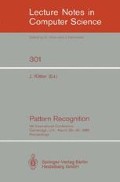Abstract
The problem of curve detection decomposes naturally into two stages: (i) inferring the (discrete) trace and tangent to the curve; and (ii) finding integrals through the resultant tangent field. Orientation selection is the term used by physiologists for the first of these stages; i.e., for the process of extracting the tangents to piecewise smooth curves from a two-dimensional image. We present an analysis of the orientation selection process from a computational perspective that is strongly influenced by various biological constraints. As such, it provides both a solid foundation for curve detection algorithms within computer vision systems and illustrates the insights that can be gained by analyzing biological vision systems. Formal extensions to the algorithm can also be posed that provide further insight into texture and optical flow.
Preview
Unable to display preview. Download preview PDF.
7. References
Dobbins, A., Zucker, S.W., and Cynader, M., Endstopping in the visual cortex as a neural substrate for calculating curvature, Nature, 1987, 329, 438–441.
Hubel, D., and Wiesel, T., Functional architecture of macaque monkey visual cortex, Proceedings of the Royal Society (London) B 198, 1977, pp. 1–59.
Gilbert, C., and Wiesel, T., Laminar specialization and intra-cortical connections in cat primary visual cortex, in F. Schmidt, F. Worden, G. Adalman, and S. Dennis (eds.), The Organization of the Cerebral Cortex. MIT Press, Cambridge, 1981.
Hummel, R., and Zucker, S.W., “On the foundations of relaxation labelling processes,” IEEE Trans. PAMI 5, 1983, pp. 267–287.
Iverson, Lee, and Zucker, S.W., Orientation selection to optical flow: a computational perspective, Proc. IEEE Workshop on Computer Vision, Miami, 1987.
Link, N., and Zucker, S.W., Sensitivity to corners in Flow Patterns, Spatial Vision, 1988a, to be published.
Link, N., and Zucker, S.W., Corner detection in curvilinear dot grouping, Biological Cybernetics, 1988b, to be published.
Orban, G.A., Neuronal Operations in the Visual Cortex, Springer-Verlag, 1984.
Parent, P. and Zucker, S.W., Radial Projection: An Efficient Update Rule for Relaxation Labelling, CVaRL Technical Report TR-86-15R, McGill University, 1985a; IEEE Trans. PAMI, in press.
Parent, P. and Zucker, S.W., Trace Inference, Curvature Consistency, and Curve Detection, CVaRL Technical Report CIM-86-3, McGill University, 1985b;IEEE Trans. PAMI, in press.
Zucker, S.W., Early Orientation Selection, Tangent Fields and the Dimensionality of their Support, Computer Vision, Graphics and Image Processing 32, 1985 pp. 74–103.
Zucker, S.W., The computational connection in vision: Early orientation selection. Behaviour Research Methods, Instruments, and Computers, 1986, 18, 608–617.
Zucker, S.W., Early vision, in S. Shapiro (ed.), The Encyclopedia of Artificial Intelligence, John Wiley, 1987.
Zucker, S.W. and Iverson, L., “From Orientation Selection to Optical Flow,” Computer Vision, Graphics and Image Processing, 37, January 1987.
Author information
Authors and Affiliations
Editor information
Rights and permissions
Copyright information
© 1988 Springer-Verlag Berlin Heidelberg
About this paper
Cite this paper
Zucker, S.W. (1988). A biologically motivated approach to early visual computations: orientation selection, texture, and optical flow. In: Kittler, J. (eds) Pattern Recognition. PAR 1988. Lecture Notes in Computer Science, vol 301. Springer, Berlin, Heidelberg. https://doi.org/10.1007/3-540-19036-8_42
Download citation
DOI: https://doi.org/10.1007/3-540-19036-8_42
Published:
Publisher Name: Springer, Berlin, Heidelberg
Print ISBN: 978-3-540-19036-3
Online ISBN: 978-3-540-38947-7
eBook Packages: Springer Book Archive

